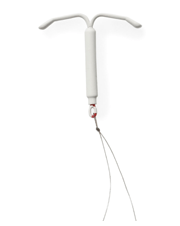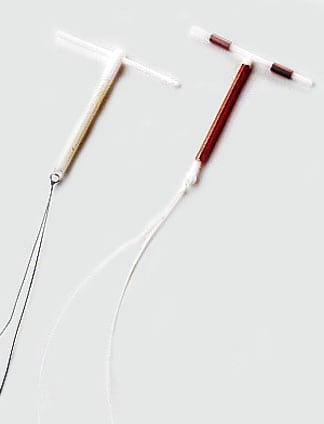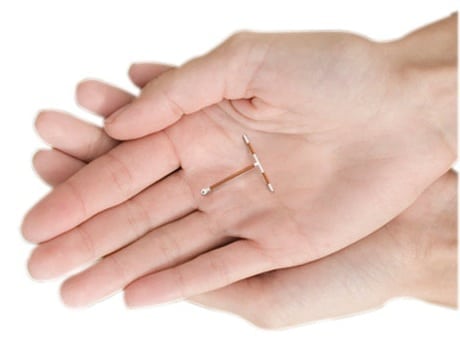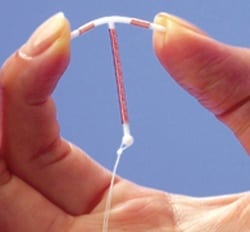Birth Control 101 is a multi-part series covering everything you need to know about birth control. It has all the details you need to make the best decision for your body, like how each method works, the pros and cons, effectiveness, cost and where to get them. After we’re done, you’ll basically be an expert, and you’ll definitely be able to make an informed decision about how to stay safe when you’re having sex.
This segment covers everything you need to know about the Intrauterine Device (IUD).
Check out our Birth Control 101 section for details on every birth control method, and Birth Control Basics for a quick and dirty overview.
Hormonal IUD
What is it?
The hormonal intrauterine device (IUD), also called Mirena (its brand name) is a small, T-shaped mechanism that is inserted into your uterus by a health care provider.
How does it work?
Mirena continuously releases the hormone progestin to prevent pregnancy for up to five years. Progestin prevents the release of an egg and causes the cervical mucus to become thicker so sperm cannot get to the egg. Progestin-only options are great for women who react strongly to estrogen. Your gynecologist or health care provider inserts the IUD into your uterus through your cervix, and may use a local anesthetic to reduce discomfort. It’s common to feel some cramping and discomfort when the IUD is inserted, and could last for a few days. Some women may feel dizzy or faint. One the IUD is places, a one to two inch string will hang down into the vagina. This helps you to know that it is still in place. It’s possible for the IUD to slip out of place, especially in the first few months or during your period, so it’s important to check for the string every few days and go to your health care provider if you cannot feel it. After five years, the IUD is removed by your health care provider.
Effectiveness
99% effective.
Pros
- IUDs are the most long-lasting, effective, invisible, hassle-free, worry-free option. You don’t even have to think about birth control for up to five years.
- Most women experience fewer and lighter periods, or no periods at all. PMS symptoms are significantly reduced, although you may get light cramping for one or two days.
- Low dose of continuous hormones, so fewer side effects.
- Cheapest method over an extended period of time.
Cons
- Having the IUD inserted can be painful. It is a more invasive procedure than other methods, and requires a doctor visit. Although you get a local anesthetic to numb the area, and it lasts only ten minutes, you will feel pressure, discomfort, and sometimes pain. Women may feel dizzy or faint during the procedure. Removing the IUD is a similarly uncomfortable process. It is also a large cost up front.
- Although periods become lighter and shorter over time, women tend to have their periods longer, heavier, and with more cramping for the first six to eight months. After that, period cycles will lessen or even diminish entirely.
- Since the IUD is an invasive procedure, there is more risk. In rare cases, it is possible that your body can reject the IUD, or that the IUD can migrate through or perforate (tear) your uterine wall. These problems could require surgery. There is also a larger chance of developing infections, and the IUD may cause scar tissue to form on your uterine walls, making it more difficult and potentially dangerous to remove.
Cost
$500 – $1,000 initially. Since the hormonal IUD lasts 5 years, this is least expensive method for long term use (besides the Copper IUD).
Where to Get It
Talk to your doctor, gynecologist, or a health or family planning clinic (like Planned Parenthood). Not all doctors insert IUDs, or are experienced in insertion and removal. Check to make sure there are no additional costs. Most doctors insert IUDs while a woman is on her period or within 7 days of the start of her period.
Copper IUD
What is it?
The copper intrauterine device (Copper IUD), also called Paraguard (its brand name) is a small, T-shaped mechanism that is inserted into your uterus by a health care provider.
How does it work?
Paraguard continuously releases copper instead of hormones to prevent pregnancy for ten to twelve years. Paraguard prevents pregnancy by changing the pH balance of the uterus, making it nearly impossible for eggs and sperm to survive. You still ovulate as normal, but the sperm cannot reach the egg, and if it did, implantation couldn’t happen. The insertion, maintenance, and removal processes are the same for the copper IUD as the hormonal IUD. After ten to twelve years, the IUD is removed by your health care provider.
Effectiveness
99% effective.
Pros
- IUDs are the most long-lasting, effective, invisible, hassle-free, worry-free option. You don’t even have to think about birth control for up to twelve years. Specifically, the copper IUD is the second most effective reversible method, behind surgical sterilization.
- Most women experience fewer and lighter periods, or no periods at all. PMS symptoms are significantly reduced, although you may get light cramping for one or two days.
- Contains no hormones, so no estrogen or progestin related side effects.
- Cheapest method over an extended period of time.
Cons
- The copper IUD has all the same cons as the hormonal IUD.
- Beyond that, a small percentage of women may have an allergic reaction to copper.
Cost
$500 – $1,000 initially. Since the Copper IUD lasts 12 years, this is the least expensive method for long term use.
Where to Get It
Talk to your doctor, gynecologist, or a health or family planning clinic (like Planned Parenthood). Not all doctors insert IUDs, or are experienced in insertion and removal. Check to make sure there are no additional costs. Most doctors insert IUDs while a woman is on her period or within 7 days of the start of her period.
Also, check out Oh Joy Sex Toys! awesome Info-comic on IUDs.
Don’t stop there… learn more about the other methods so you can find the perfect fit! Check out these articles in our Birth Control 101 series.
Birth Control 101: The Basics of Birth Control
Birth Control 101: The Pill
Birth Control 101: The Patch
Birth Control 101: The Ring
Birth Control 101: The Shot
Birth Control 101: The Implant
Birth Control 101: Hormonal and Copper IUDs
Birth Control 101: Male Condoms
Birth Control 101: Cervical Cap
Birth Control 101: Diaphragm
Birth Control 101: The Sponge
Birth Control 101: Spermicide
Birth Control 101: Pull Out Method
Birth Control 101: Emergency Contraception (Plan B)
Common Birth Control Myths
Sources “Birth Control Methods.” Bedsider Birth Control Support Network. Bedsider, n.d. Web. 27 July 2013.
“Birth Control Methods.” Planned Parenthood. Planned Parenthood Federation of America, 2013. Web. 27 Jul. 2013.
Blynn, Jamie. “Understanding IUDs: Is It the Right Birth Control For You?” Her Campus. Her Campus Media, 21 Oct. 2011. Web. 03 Aug. 2013.
Hoxworth, Laura. “Forms of Birth Control You Might Want to Try (Beyond the Pill).” Her Campus. Her Campus Media, 7 Jan. 2011. Web. 27 July 2013.
Levin, Sammie. “The Pill, The Shot, IUD’s & More: How To Figure Out Which Type of Birth Control Is Right For You.” Her Campus. Her Campus Media, 21 Aug. 2012. Web. 27 July 2013.
Taylor, Andrea. “We Asked an Expert: Which Birth Control Is Best?” Kinkly, 16 Jan. 2013. Web. 27 July 2013.
“The Ultimate Guide to Safer Sex.” Greatist, n.d. Web. 27 July 2013.
“Types of Contraception.” Advocates for Youth, 17 Jan. 2012. Web. 27 July 2013.







It’s also worth noting that copper IUDs are an effective form of emergency contraceptive (even more effective than hormonal EC), for up to 7 days after unprotected sex.
That’s awesome!! I had no idea. Definitely going to research that more… maybe a post about it soon! 🙂